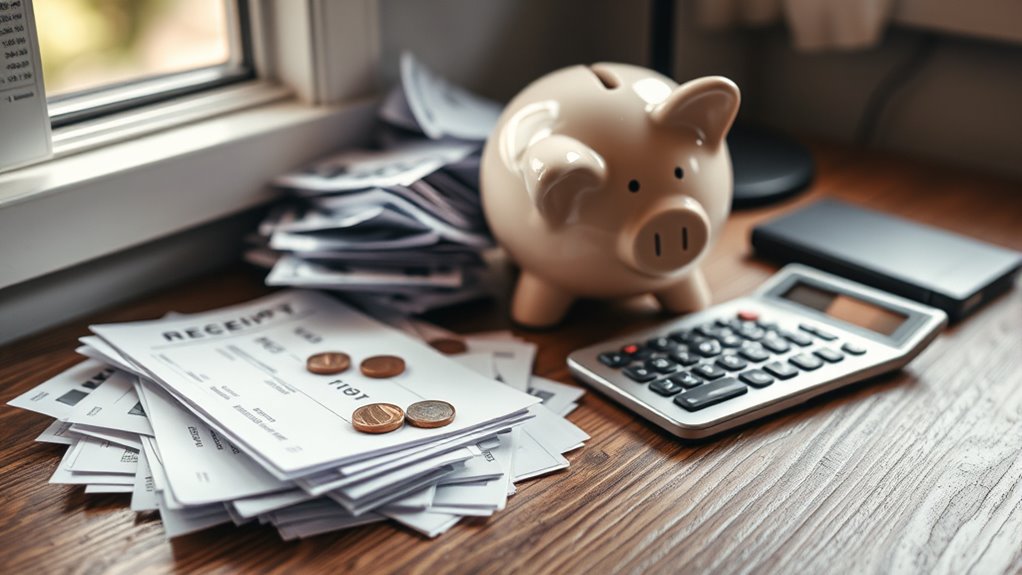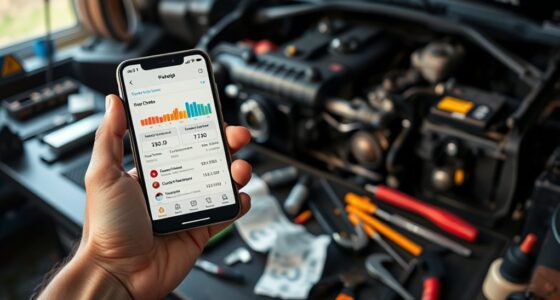Building an emergency fund for car repairs is essential to handle unexpected costs without stress. Start by saving a small amount each month in a separate account dedicated to repairs. Automate your deposits to stay consistent and avoid spending the money elsewhere. Regularly maintain your vehicle and stay informed about common issues and costs. With these steps, you’ll be better prepared for surprises on the road, and you’ll discover more tips on building a solid fund as you continue.
Key Takeaways
- Start a dedicated savings account for car repair funds and make consistent monthly deposits.
- Automate contributions to ensure regular saving and avoid spending the set-aside money.
- Maintain detailed vehicle maintenance records to prevent costly breakdowns and plan for upcoming repairs.
- Research common vehicle issues and associated repair costs to set realistic savings goals.
- Understand your insurance coverage to supplement savings and reduce unexpected expenses.

Have you ever faced unexpected car repairs that left you scrambling for cash? It’s a stressful situation that can catch you off guard, especially if you’re unprepared. Building an emergency fund for car repairs is essential to avoid financial strain when your vehicle suddenly needs fixing. One way to start is by understanding how your insurance policies can help. While insurance isn’t meant to cover every repair, it does protect you from major accidents and damages. Knowing what your policy covers, including roadside assistance or rental car reimbursements, can give you peace of mind and reduce out-of-pocket expenses. However, insurance alone won’t cover all repairs, so setting aside your own savings is vital.
Unexpected car repairs can strike anytime—understand your insurance and save proactively to stay prepared.
You should also pay close attention to your vehicle’s maintenance schedule. Regular maintenance doesn’t just keep your car running smoothly; it also helps you spot issues early before they turn into costly repairs. When you follow your manufacturer’s recommended maintenance schedule, you’re proactively preventing breakdowns and avoiding emergency repairs that drain your funds. Scheduling routine oil changes, brake checks, and tire rotations can seem simple, but these small steps can save you a lot in the long run. Plus, keeping detailed records of maintenance can help you identify patterns that might indicate upcoming problems, enabling you to address them early. Being aware of common issues and their costs, such as bad lemon juice, can help you make informed decisions about repairs.
To build your emergency fund effectively, start small and be consistent. Set aside a specific amount of money each month, even if it’s just a few dollars. Over time, these savings add up, giving you a buffer to cover unexpected repairs without disrupting your budget. Consider opening a dedicated savings account labeled “Car Repair Fund” to keep the money separate from your regular expenses. Automate deposits if possible, so you don’t forget or feel tempted to spend it elsewhere. It’s also wise to adjust your savings as your vehicle ages or if you buy a different car, since older cars tend to require more repairs.
Finally, stay informed about your vehicle’s condition and costs associated with repairs. Research common issues for your car model and learn about typical repair costs. This knowledge helps you plan better and avoid surprises. Remember, building an emergency fund isn’t a one-time effort; it’s an ongoing process that provides security and peace of mind. With a combination of understanding your insurance coverage, adhering to maintenance schedules, and disciplined saving, you’ll be better prepared to handle any unexpected car repair bills that come your way.
Frequently Asked Questions
How Much Should I Ideally Save for Car Emergencies?
You should aim to save at least $500 to $1,000 for car emergencies. This covers unexpected repairs like broken brakes or engine issues. Consider your insurance premiums and maintenance schedules—if your car requires frequent maintenance, save more. Regularly review your fund and adapt as needed, especially if you notice upcoming expenses. Having enough set aside ensures you’re prepared without disrupting your finances when sudden repairs come up.
What’s the Best Way to Start an Emergency Fund With a Tight Budget?
Starting an emergency fund on a tight budget might seem tough, but it’s doable with budget-friendly strategies and saving techniques. You can begin by setting aside small amounts regularly, even just a few dollars a week. Automate your savings to stay consistent, cut unnecessary expenses, and look for extra income sources. Over time, these small efforts will grow, providing a safety net for unexpected car repairs without straining your finances.
How Often Should I Review or Update My Emergency Fund?
You should review your emergency fund at least once every three to six months. During these checks, consider maintenance checks on your vehicle and evaluate if loan refinancing options could free up more cash to boost your fund. Regular reviews help guarantee your savings stay aligned with your needs, especially if your expenses change or you encounter unexpected repairs. Staying proactive keeps your emergency fund reliable when you need it most.
Can I Use a High-Yield Savings Account for My Emergency Fund?
Imagine your emergency fund as a safety net, ready to catch you when unexpected car repairs hit. Yes, you can use a high-yield savings account for this purpose. It offers attractive interest rates, helping your money grow while remaining accessible. This makes it an excellent investment option, balancing safety and growth, so you have funds on hand when emergencies strike without sacrificing earning potential.
What Are Common Unexpected Car Repair Costs I Should Prepare For?
You should prepare for common unexpected car repair costs like brake replacements, tire blowouts, or engine issues. Regular maintenance reminders help spot problems early, saving you money. It’s also wise to budget for roadside assistance, which can cover towing or emergency repairs if you’re stranded. Having an emergency fund guarantees you can handle these surprises without stress, keeping your car running smoothly and your finances secure.
Conclusion
Think of your emergency fund as a sturdy lifeboat in rough waters. When unexpected car repairs strike, this fund keeps you afloat, preventing stress from sinking your finances. By building and maintaining it, you’re creating a safety net that catches you before you fall. Keep adding to your fund regularly, so you’re always ready to navigate any storm that comes your way. A well-prepared emergency fund is your anchor in unpredictable times.









